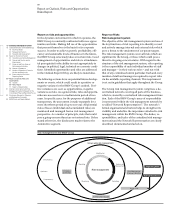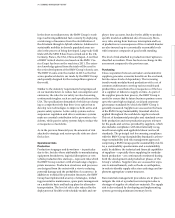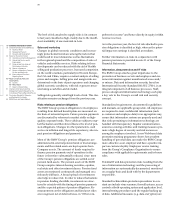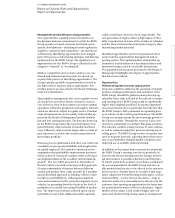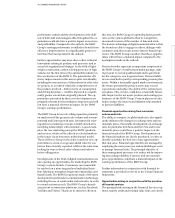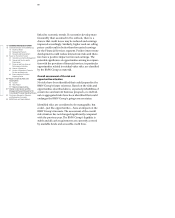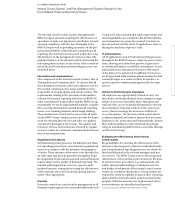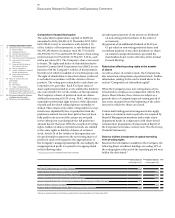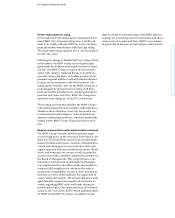BMW 2013 Annual Report Download - page 77
Download and view the complete annual report
Please find page 77 of the 2013 BMW annual report below. You can navigate through the pages in the report by either clicking on the pages listed below, or by using the keyword search tool below to find specific information within the annual report.
77 COMBINED MANAGEMENT REPORT
Report on Outlook, Risks and Opportunities
Report on Opportunities
Management and identification of opportunities
New opportunities regularly present themselves in
the dynamic business environment in which the BMW
Group operates. General economic trends and sector-
specific
developments – including external regulations,
suppliers, customers and competitors – are monitored
continuously. Identifying opportunities is an integral
part of the process of developing strategies and drawing
up forecasts for the BMW Group. The significance of
opportunities for the BMW Group is classified in the
categories “material” or “not material”.
Market, competition and scenario analyses are con-
ducted and evaluated and forecasts are drawn up
as part of the process of identifying opportunities. The
Group’s product portfolio is permanently reviewed in
the light of these analyses and, as appropriate, new
product projects are presented to the Board of Manage-
ment for consideration.
Opportunities management also covers regular reviews
of cost drivers and other factors critical for success.
One of the key areas in this context is to ensure optimal
operations within the production and supplier network,
which are therefore subject to regular review. Potential
areas of improvement can be quickly realised after ap-
proval by the Board of Management and the benefits
factored into earnings forecasts. The forecasts drawn up
by the BMW Group reflect the expected impact of tar-
geted efficiency improvements on variable and fixed
costs. Efficiency improvement targets take account of
past experience as well as the current composition of
the product portfolio.
Business process optimisation and strict cost control are
essential to ensure good profitability and a high return
on capital employed. The outlook is drawn up on the
assumption that profitability improvement measures
will be achieved. One good example of this is the rigor-
ous implementation of the so-called “architectural
ap-
proach”. The new MINI presented in November is
the first vehicle to be built on the basis of this
approach.
Greater communality of features between different
models and product lines, made possible by a modular
and architectural approach to building vehicles, helps
to improve profitability by reducing development
costs
and investment on the series development of new
vehicles, by generating benefits of scale at the level of
production cost and by increasing flexibility in produc-
tion.
The improved cost basis achieved opens up op-
portunities
to move into additional market segments
which would have otherwise been unprofitable. The
new generation of engines allows a high degree of
flexi-
bility in production in terms of the number of cylinders
and the choice between diesel and petrol engines, thus
maximising market potential.
Identified opportunities can be incorporated at short
notice into the opportunities management and re-
porting
system. The implementation of identified op-
portunities is undertaken on a decentralised basis and
monitored using a variety of suitable instruments.
The quarterly forecast report presented to the Board of
Management highlights the impact of opportunities
that have been realised.
Opportunities
Political and global economic opportunities
Economic conditions influence the operations, financial
position, earnings performance and cash flows of the
BMW Group. Should the global economy develop sig-
nificantly better than reflected in the outlook, revenues
and earnings of the BMW Group could be significantly
higher than originally predicted. Economic
opportuni-
ties present themselves in particular from the fact that
the BMW Group is fully committed to expanding busi-
ness volumes in the world’s growth markets. The BMW
Group sees an opportunity for above-average growth in
the Chinese market. Potential for recovery is also seen
elsewhere, particularly in southern European countries.
The outcome could be a sharp increase in sales volumes
as well as reduced competitive pressure and improved
selling prices. The BMW Group reviews its market
fore-
casts at frequent intervals, adjusting them when
neces-
sary to accommodate changed market conditions and
make full use of available market potential.
In addition to the impact from economic developments,
the BMW Group’s earnings can also be positively af-
fected
in the short to medium term by changes in the
le-
gal environment. A possible reduction in tariff barriers,
in import restrictions or direct excise duties could lower
the cost of materials for the BMW Group and also en-
able products and services to be offered to the customer
at lower prices. Another factor to consider is that regu-
latory support for forward-looking technologies, such as
electromobility – in the form of incentives – help to
make the total cost of ownership more attractive for the
customer, thus opening up opportunities for faster mar-
ket penetration by means of these technologies. Oppor-
tunities of this nature could result in higher sales vol-
umes and, all other things being equal, to an improved



